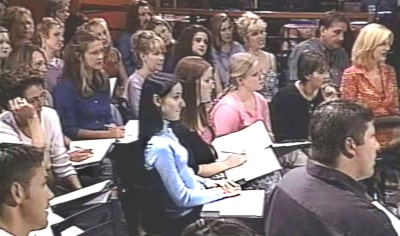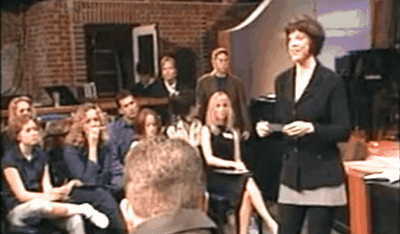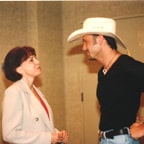HOW TO SING THE STAR SPANGLED BANNER
Our country’s national anthem is one of the most difficult songs to sing. It is also the one song that almost every American singer will have to sing sometime in their career.
This song has such a troublesome wide range that most singers need help with it.
Two-time Grammy winner Kix Brooks (Brooks & Dunn) came to work with me on it. He was to sing the national anthem a cappella for a Tennessee Titans football game and wanted to be sure he could hit the high notes as well as the low notes. We must have pushed the right buttons, because I heard quite a few people, who didn’t know I had worked on it with him, comment that Kix really “nailed it” at the game.
Before you begin reading these tips take a moment and make a permanent recording of yourself singing the Star Spangled Banner. I want you to have a reference marker to go back to so you can hear the difference these tips make in your performance of this song.
TIP #1 – THINK ABOUT THE WORDS
Most of us have heard our American national anthem since we were small children. Perhaps we know the words so well we no longer pay attention to what they mean? This is important because the Star Spangled Banner is the one song a singer is most likely to be asked to sing. Here’s the good news and the bad news.
The good news is that the popularity of the American national anthem offers singers the opportunity to perform in public, often in front of thousands of people at civic or sporting events.
The bad news is that the Star Spangled Banner is fiendishly difficult to perform. Oh, and we’re usually expected to sing it a cappella—without instruments!
But it all starts with the words. Many singers sing the Star Spangled Banner with little or no emotion. In other words, without giving much thought to the words and story behind the song. If you want to make a strong impression with the national anthem, think about the words and figure out what they really mean to you.
Do some homework and brush up on what was happening during the War of 1812, when Francis Scott Key put quill to paper and wrote these words. The Star Spangled Banner is about a fierce all-night battle during the War of 1812 and expresses the writer’s concern about whether our flag was still flying over our fortress at dawn.
FRANCES SCOTT KEY
You must think about the words and what they stand for if you want to give our national anthem the attention it deserves. How lucky we are to live in this great country. We have our freedom thanks to millions of brave men and women who fight so we may keep that freedom. This song honors them.
TIP #2 -FLYING IN THE FACE OF TRADITION
Notice that the entire first verse of the Star Spangled Banner is made up of only two sentences. The first sentence is really, really long and the whole song is full of phrasing and breathing landmines.
Dangerous phrasing issues occur when the natural word-related phrase breaks come into conflict with the natural rhythmic and harmonic phrase breaks. Usually songwriters put important words on accented beats and on the higher notes. Our national anthem flies in the face of this tradition; some of the accents and words don’t match up to each other, making it appear to be acceptable even desirable to breathe in the middle of words.
If you go strictly by how it fits into the musical framework, this song seems most successful when it is taken in small manageable phrase units with clearly defined breaks in between them.
The national anthem gives us lots of space for breaks in the rhythm. Don’t be afraid of silence. Be certain to give listeners time for a heads-up by lengthening the starting consonant of the important words. Go early to, and lengthen, the final consonants to give us time to reflect on the words that have just been sung.
There is no need to rush. Try it this way. “Oh, say (breath) can you see (breath) by the dawn’s early light” (breath) etc.
TIP #3 – RANGE IS KEY
You’re in for a rough time if you start off on the wrong key—too high or too low. You risk losing at least one part of your range, either the top or the bottom.
The Star Spangled Banner is not easy to sing. Its range stretches one complete octave and a half. If you choose a key that lets the low notes sound rich and full, the top notes may suffer. A key that helps you hit the high notes easily may make your low notes impossible.
Carry a pitch pipe or use a smart phone pitch pipe app. Do Not try to guess the starting note! You will no doubt be excited by the prospect of performing and probably start too high. And, you will live to regret it when the real high notes do come around.
Choose a key that allows you to sing on a step-ladder of high notes, followed by even higher notes. Some parts, like “red glare” are very difficult to sing. It’s hard to get up to “red glare” because it falls at the end of what seems to be a never-ending ladder of high notes.
TIP #4 – LET’S HIT THOSE HIGH NOTES
Make certain you’re breathing down low into what appears to be your lower abdominals. Resist reaching up with your chin to power the high notes. Try this: sing or hum a long note as you slowly dip your chin to your chest. Then raise it upwards, letting your head fall back. Continue to hum and you slowly go back and forth several times.
Do you see how simply tipping your head back chokes off the sound and makes your voice sound thin? Instead of tipping your head back, power the sound with strength from your lower body. Bend your knees slightly, as though you were going to pick up a heavy piece of furniture or start to dance the Limbo. Push your feet into the floor when you reach for the high and low notes.
Take time to watch the video here and to digest the information about how to achieve lower body breathing and support. This is not something you do only when you sing.
To make it a habit, you should breathe and support this way all the time, especially when you’re speaking. In fact if you apply these techniques to your speaking voice they will become natural to you much faster.
TIP #5 -THE AMAZING POWER OF CONSONANTS
One of the most powerful tools a singer needs to learn is how to use what I call the amazing power of consonants to emphasize the important words in this or any song.
Go though the song and choose the words you feel are the most important and emphasize them by going early to and lengthening the consonant at the front of that word. “Oh, say can you see, by the dawn’s early light, what so proudly we hail’d at the twilight’s last gleaming, whose broad Stripes and bright Stars through the perilous fight…” Consonants bring out the emotion in a song. There is no right way or wrong, it’s up to you, the singer, to choose which words you feel are most important.
Watch the video, on YouTube, of Lady Gaga when she sang the Star Spangled Banner at the 2016 Super Bowl. Notice how she sings on the consonants, how she draws them out to put emphasis on those words she feels are the very essence of the song.
Listen to your favorite singers, I can almost guarantee that they sing on the consonants. Take time with every song you sing to choose those words that you feel are the most important and bring out the emotion by singing on early consonants.
If you didn’t follow my suggestion in Tip #2, take time now to listen to Nat King Cole. Pay attention to the way he lengthens the consonants. This is how you really bring out the emotion in a song. He’s a master at it!
TIP #6 – LET’S WALTZ!
I could go on and on with information to help you sing this wonderful song. Five Tips just don’t seem to be nearly enough, so I decided to give you an extra bonus tip to help put this problem song to rest. Be sure to apply what you’ve learned about singing the Star Spangled Banner to all of your other songs. You will be amazed at the difference these tips will make.
Do you realize that the Star Spangled Banner is actually a waltz? That surprised me. But, I should have known because of the way the tempo seems to drag in the hands of so many singers. Always late. There is a tendency to drag music with a time signature that is based on three. This especially includes waltzes. Singers tend to drag on beat three, slowing down the forward movement at the end of each bar.
When you perform the national anthem keep your vocal energy up and don’t let yourself get stalled at beat three. Avoid this by heading directly for the following downbeat instead. In fact, go a little early to the next downbeat and use that energy to propel your voice forward across the bar line.
Do you remember in Tip #1, I asked you to record yourself before learning these tips? I would like you to record yourself once again when you feel you have mastered these techniques. Listen to your first recording; then compare the two recordings. See how much better you sound?
Check out my other article - The Irrational National Anthem

Renee Grant-Williams explains her tips, tricks, and techniques. Her Master-Class Program lets you inside as she coaches and guides real people to find and sing their best voice

If you found, and enjoyed this article and have not signed up for Renee's newsletter, check it out below.
Click on the Video for a message from Renee about her Free Video Newsletter.
YOU WILL LEARN: Singing with Emotion, Passive Breathing, Creative Phrasing, Sound Production, Career Planning and much, much more.
What others say about Renee's techniques.

Miley Cyrus
"I miss you so much! My voice is so much better now. I can hit high notes without sounding like a dying German Shepherd."

Tim McGraw
"Renee has my changed my whole approach. Her teaching has given me a lot more confidence in my singing ability."

Rod Essig
Creative Artist Agency
"...So When they have a little problem, I say here's a phone number to call."

Bob Weir
Grateful Dead, Bobby Weir & Wolf Bros
"Renee is the best vocal coach in the world!!!"

Mary Steenburgen Actress, Singer, Songwriter
"I think Renee is a genius!"
Check out Renee's Merch
See our SITEMAP for lots of resources.


